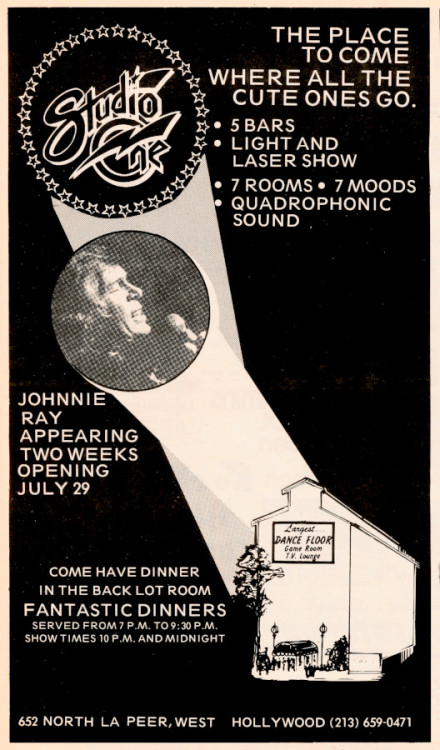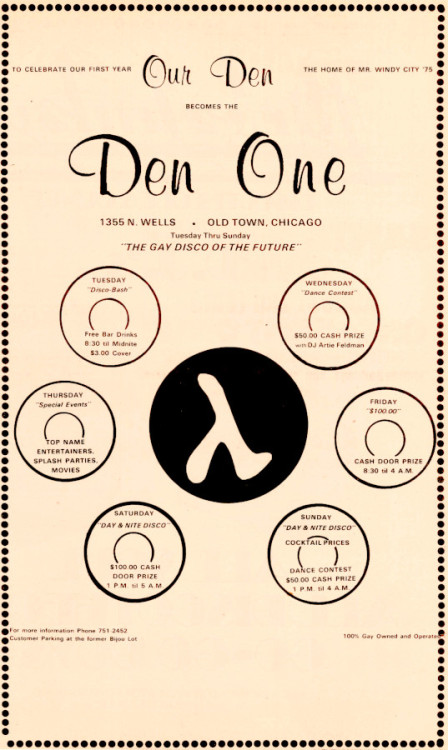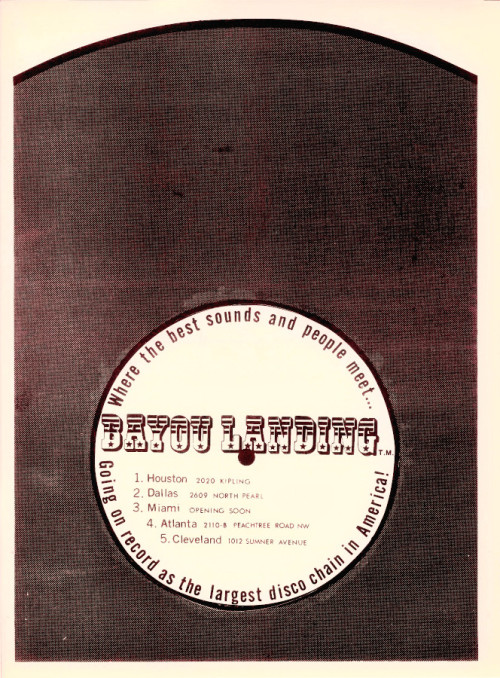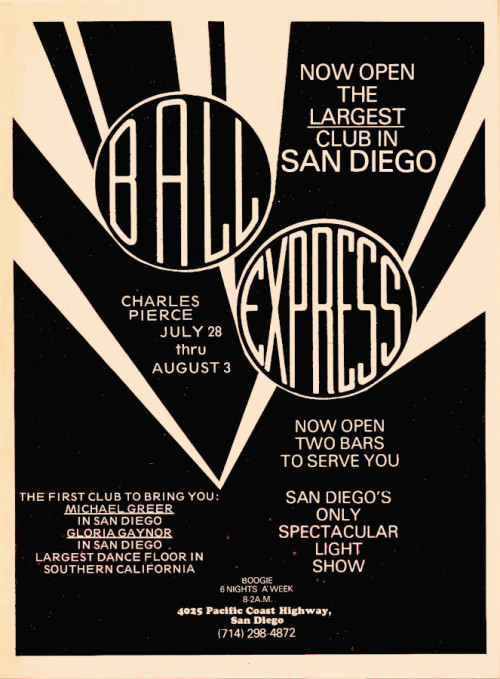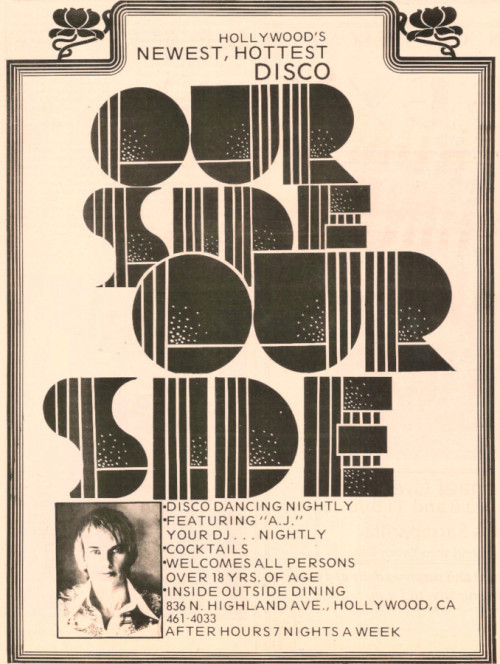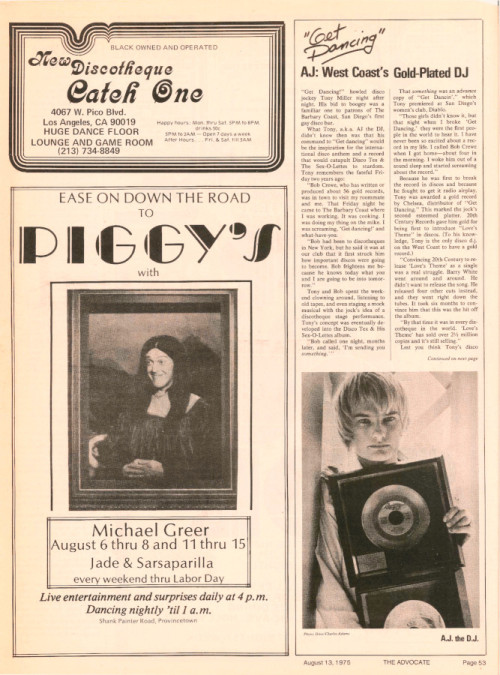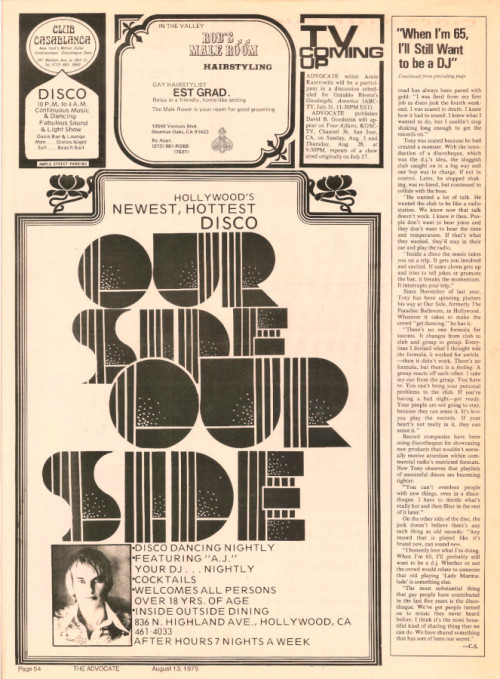#gay discos
Ad for Studio One(652 N. La Peer, West Hollywood, CA).
There’s quite a bit about Studio One out there, one of LA’s pre-eminient disco venues. However, the venue’s legacy these days is tainted by accounts of its racist door policies, which had been the subject of community protest, multiple times.
According to the ONE Archives page on Studio One, “[t]hree pieces of identification were required before even being admitted to the club and that was only if diversity quota has not been met for the night. Women and minorities were turned away from the door while white males were always admitted.”
Regarding this particular ad, I was intrigued by the advertisement for Johnnie Ray’s appearance there, likely at its popular cabaret venue, The Backlot. Someone I hadn’t known of until I saw this ad, Johnnie Ray is an interesting figure in queer pop cultural history. Hearing impaired from a young age, Ray was something of a Rock & Roll pioneer, having come up playing black establishments like Detroit’s Flame Show Bar, where he was known for his emotive, theatrical style. Though never ‘out’ in the quasi-official way we think of today, his queerness remains widely acknowledged. If nothing else, signature songs like “Cry” and “Hernando’s Hideaway” certainly speak to decidedly queer themes and audiences. Battling alcoholism throughout much of his adult life, Johnnie Ray died of liver failure in 1990 at the age of 63.
Post link
Ad for Our Den AKA Den One(1355 N. Wells, Chicago, IL).
Located in Chicago’s Old Town neighbourhood, Den one was a gay venue catering to a mixed black and white clientele. In 1977, 19 year-old House pioneer and legend Ron Hardy would establish his first DJ residency at Den One (see Jacob Arnold’s excellent article about Ron Hardy’s Den One residency at RBMA).
At the time of this ad however, its DJ was Artie Feldman, a regular Chicago contributor to Vince Aletti’sDisco File columns in Record World. By 1978, it would become Carol’s Speakeasy, named after its owner Richard Farnham AKA Mother Carol. Its closure in 1991 appears to have been precipitated by its unfortunate connection to serial killer Jeffrey Dahmer, when it was found that Dahmer picked up one of his victims, 23 year-old Jeremiah Weinbergerthere.
Even as the neighbourhood gentrified around it, 1355 N. Wells would remain abandoned until around 2016 or so, the last time the building appears on Google Street View. By 2017, the building appears to have been demolished.
Post link
Ad for Nickelodeon(141 Mason St., San Francisco, CA).
This venue got a brief mention in Bob Kiggins’ San Francisco Disco Scene column, as a place “where boys can be girls.” Interesting as a document of burgeoning disco DJ culture for an establishment to feature their music and sound above anything else - “ALL SOUL, ALL DISCOTHEQUE,” with the names and photos of their DJs - Allan FrostandDon Miley front and centre.
Not sure how many other discos would employ Universal Studios’Sensurround system (first used on the 1974 film Earthquake) but they made sure to include that in the ad too.
Don Miley would go on to have credits as a writer and/or mixer on records coming out of, or connected to the San Francisco scene, like “Tell Everybody” and “Doin’ It” by Herbie Hancock, and “Get The Feeling” by the Two Tons O’ Fun. Miley also appears to have been one-time DJ and singer Frank Loverde’s manager in the early 80s.
Post link
Ad for the Bayou Landing chain of gay bars and discos in theUS southandmidwest ran by entrepreneur Dennis Sisk and business partner Tony Caterine that seems to have rose as quickly as it fell.
Another half-page ad in the issue (see The Supremes Interview) advertises the opening of their newest Cleveland location. Some of it’s branches became independent gay venues, like the one in Houston, which became The Old Plantation (probably not long after this ad was printed). Though one would question the inclusivity of a name like that today, The Old Plantation would spawn a mini-chain of its own.
Dallas’D Magazine has a fascinating archived piece from 1979 called Lords of an Underground Empire which in part, details the rise of The Old Plantation(s) in both Dallas and Houston and the decline of Bayou Landing chain, with its founders, Sisk and Caterine ending the decade embroiled in drug and fraud charges.
Post link
Ad for Ball Express(4025 Pacific Coast Highway, San Diego, CA).
Housed in a former airplane hangar, the suggestively named Ball Express was apparently the first and biggest gay disco in San Diego and by various online accounts, the place to be in San Diego’s gay scene in the ‘70s. Gloria Gaynor, Eartha Kitt and Sylvester are all said to have played there.
Ball Express is one of the establishments mentioned in the documentaryaboutSan Diego’s Gay Bar History aired by San Diego’s PBS affiliate, KPBS. The venue appears to have lasted from around 1974-1978, reportedly done-in as a result of “storm damage to the roof and slow weeknights.” See an amusing review from 1976 in the San Diego Reader calling it “a segregated in-spot” worth going to for “loosening screws in one’s perspective.”
Post link
Concluding this series of transcribed articles from The Advocate’s August ‘75 ’Discos!“ issue is an interview w/ Hollywood DJ, A.J. Miller.
While not much is known about whatever happened to Miller, the interview is an interesting look into just how influential gay DJs and discos were.
At the time Miller was working at a club called Our Side, which had formerly been the The Paradise Ballroom (owned by the notorious Eddie Nash), which would later become the long-running Probe. Miller was apparently also a close associate of the late writer/producer Bob Crewe and was instrumental in his disco productions at the time.
I love Miller’s last line - “[t]he most substantial thing that gay people have contributed in the last five years is the discotheque. We’ve got people turned on to music they never heard before. I think it’s the most beautiful kind of sharing thing that we can do. We have shared something that has sort of been our secret.”
Scans and full transcription on the main blog.
Post link

